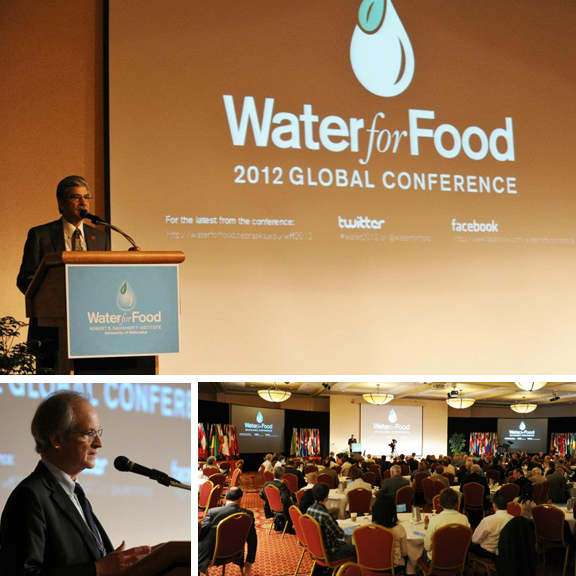
Examples of how water use can be managed successfully to feed a growing world population can be found in locations as diverse as Nebraska and India, but there’s no one-size-fits-all solution to the challenges ahead, said the director of the Robert B. Daugherty Water for Food Institute at the University of Nebraska on May 30.
Several speakers at the fourth annual global Water for Food Conference pointed out that changing what people eat will be a key component of solving the looming crisis.
Roberto Lenton, who became executive director of the Daugherty Institute in February, opened the conference, which is expected to draw more than 530 people from 26 nations to discuss the research, education and policy implications of feeding a world whose population is expected to grow from 7 billion to 9 billion by 2050, while using less water for agriculture.
Colin Chartres, director general of the Sri Lanka-based International Water Management Institute, defined the stark challenge this way: Based on current trends, by 2030 the world will need double the water it requires now.
“How we deal with water scarcity over the next 10 to 20 years will have a fundamental impact on food security, poverty reduction and the environment in years to come,” Chartres said.
Lenton stressed that while the challenges are global, the solutions must be devised locally because of differences in water availability and technological and policy options. Lenton cited Nebraska and India as examples.
Nebraska, which leads the U.S. in irrigated acreage, will celebrate this year the 40th anniversary of creation of its unique natural resource district system that puts groundwater management in the hands of local units of government with locally elected boards and taxing authority.
“This was a landmark event,” Lenton said, adding that even as irrigation has continued to increase, NRD management, as well as a University of Nebraska-Lincoln-created water management network, have helped the water table remain relatively stable.
In a region of India, meantime, it was urban dwellers’ concern about water sanitation that drove changes in watershed management upstream and, ultimately, encouraged those upstream villages to come up with a system to divide water equitably and protect the watershed.
Lenton said water management means different things to different people, ranging from a household to a global perspective. For example, he noted, a farmer focuses on how to maximize yield with the water available to increase profits, while national policymakers consider how to ensure food security for citizens while minimizing water used by agriculture so other needs can be met.
“Most of us in this room generally think of one scale or maybe a couple,” Lenton said. “We can’t solve a global issue if we can’t understand what’s happening on other levels.”
While this is Lenton’s first Water for Food Conference, NU President James B. Milliken noted that the Water for Food Institute already is making important strides. He noted the establishment of several partnerships with both private and governmental entities from around the world and said more are to come.
The institute’s mission is to educate not just scientists about the challenges, but also policymakers and citizens, beginning with the youngest, those in K-12 schools, Milliken said.
Another speaker, Malin Falkenmark, senior scientific adviser at the Stockholm International Water Institute, said good management of “blue water” and “green water” is critical. Blue water is drawn from aquifers, rivers and lakes and green water falls as precipitation.
By 2050, she warned, 46 percent of the world will live in areas with blue-water shortages. Falkenmark said managing diet expectations is important. Even with projected yield increases, there won’t be enough water to support a diet of 3,000 kilocalories a day if 20 percent of those calories come from meat. She said there would be “just enough” for a diet with 5 percent of the calories coming from meat.
That would be a significant shift, not just for people in the developed world but for those in the developing world whose diets tend to include more meat as wealth rises.
In addition to a diet with less meat, Chartres said any solution to feeding more people with less water must include: a reduction in waste, both in production and consumption; encouragement of trade, with water-hungry crops grown in water-rich areas; and increased production.
These steps will require political leadership, new policies, regulation enforcement, reform of governments and institutions and more, Chartres added.
The conference continues May 31 and June 1 at the Cornhusker Hotel. This year's presentations focus on the conference theme, "Blue Water, Green Water and the Future of Agriculture.” It is hosted by the Daugherty Institute and the Bill & Melinda Gates Foundation.
Conference updates can be found on Facebook at https://www.facebook.com/waterforfoodinstitute and Twitter, @waterforfood, or by following #water2012.
— Dan Moser, IANR News